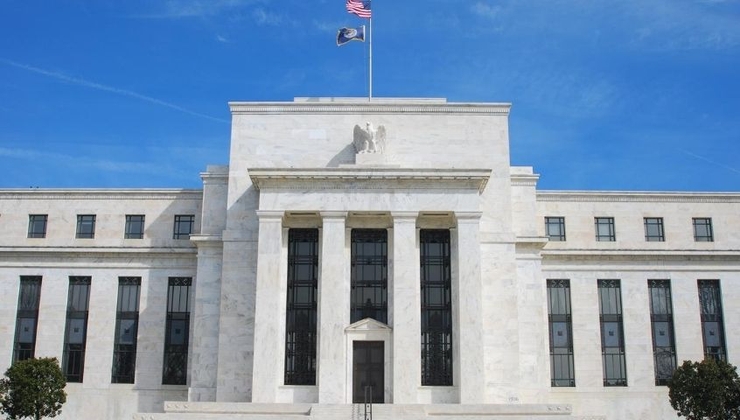- English
- 简体中文
- 繁体中文
- ไทย
- Tiếng Việt
- Español
- Português
- لغة عربية
Analysis
Dollar Index (DXY):
Turnaround Tuesday certainly didn’t occur for risk assets as very solid JOLTs job openings and US consumer confidence data led the market to believe that the Fed could stick to their hawkish script. Additionally, news that Taiwan had fired at a Chinese drone saw a geopolitical risk premium priced in. As Wednesday trading got underway the dollar seems to be benefiting from safe haven bids as risk sentiment continues to deteriorate. It is also tussling with the prospect of USD selling due to month end rebalancing.
The newly revamped ADP payrolls calculation method, which now also indicates pay metrics disappointed analysts’ expectations for a gain of 300k. The ADP figure came in at a paltry 132k. If this new calculation method is more accurate in its predictive abilities then Friday’s NFP number could be a significant disappointment (market expecting 300k). The pay data shows still hefty wages pressure with job-stayers experiencing 7.6% and job-changers seeing an annual increase of 16.1%. Leisure/hospitality and trade/transportation/utilities were responsible for the majority of job gains.
Risk-off is helping keep the dollar bid as the S&P500 slips further below the 4k level towards its 23.6% Fibonacci level. The Fed’s QT of $95bln also began yesterday, which could further pressure US equity markets. Initial jobless claims, were a positive vs the ADP out yesterday with 232k vs 248k expected as well as seeing the previous month’s number revised lower to 237k from 243k. The US ISM Manufacturing data was flat compared to the previous month at 52.8, but managed to beat expectations of 51.9. Running a ruler across the subcomponents, firstly, inflation via the prices paid was a lot lower than expectations, which will be a welcome relief. New orders and the employment component, however, were solidly both above expectations and the previous month’s reading.
The Atlanta Fed GDPNow forecast for Q2 is now at 2.6% vs 1.6% previously. The NFP will drop soon and the market expects a headline gain of 300k jobs. Average hourly earnings will be another key metric to be on the lookout for. The YoY print is expected at 5.3% vs 5.2% previously and the MoM at 0.4% vs 0.5% previously. A solid above consensus print could push the dollar higher into the weekend. It’s already taken out the August 29 highs of 109.218.

Taking a look at the charts we got to within a whisker of 110. The RSI sits in overbought territory, but not extremely overbought, providing some further room for gains. There is some negative divergence which is usually a bearish signal. The next major level of support is around 108.
EURUSD:
The hawks were out as the week got underway with Knot and Muller pushing for the ECB to join the 75bps club. ECB’s Nagel also spoke to the importance of frontloading hikes to reduce risks of de-anchored expectations. Eurozone CPI surprised to the upside with core at 4.3% vs 4.1% exp and the headline figure printed at 9.1% vs 9% exp. This shows that the stickier components are still experiencing price pressures. We know from the July meeting that the inflation picture needed to improve for the ECB not to hike by more than 50bps. The ECB’s Holzmann believes that 50bps is the minimum next week and that 75bps should be debated. Danske, Nordea, JPM, Goldman, Credit Suisse and BofA are all seeing 75bps now at the September meeting. Markets have priced 70bps.
The other positive factor for the euro has been the slump in gas and electricity prices. As high prices caused some demand destruction as well as over 80% storage levels being achieved. Additionally, there is plenty talk of intervention including price caps, reducing power demand and windfall taxes to help households and businesses. Nord Stream 1 is undergoing maintenance for 3 days since Wednesday. Thursday brought some decent German retail sales data, beating pessimistic forecasts. Eurozone unemployment rate came in line with expectations at 6.6%. Some news flow regarding the energy situation came through on Thursday evening. Gazprom stated that full inventories can’t guarantee a safe winter in the EU. Shortly after this Germany said they feared further cuts in gas flows from Russia in October. On a more positive note Nord Stream 1 flows are expected to resume early Saturday from their 3-day hiatus.

EURUSD bounced off the 0.989 support which has provided some stickiness on previous sell-offs. Parity is the next major resistance level. The RSI is moving from close to oversold territory. The 21-day EMA has been capping gains recently so on a move higher, it will be interesting to see if this barrier can be overcome.
GBPUSD:
Well if people thought the Citi estimate of UK inflation hitting 18.6% was bad, then Goldman really injected a bit of a shock factor. Goldman economists said that if energy prices stayed at these elevated levels, that would push up inflation to 22.4% and trigger a 3.4% decline in GDP. Given currencies are being driven by global growth dynamics, the very ominous UK economic forecasts, ballooning current account deficit and deeply negative real rates are emboldening short sellers. I can’t find a single positive factor about the quid at the moment. The Citi/YouGov Poll of UK public inflation expectations based on 5-10 year time horizon jumped up to 4.8% from 3.8%, that should concern the BoE about de-anchored inflation expectations. This toxic mix of bearish headwinds has led to Cable sliding below 1.16 and now close to March 2020 covid lows of 1.14098. A strong NFP number today could be the catalyst to reach that level.

In terms of downside levels to have on the radar 1.15 and 1.14 March 2020 Covid lows would be key. On the upside, 1.175 is the next major resistance level. The RSI is showing negative divergence and could be where sellers begin to run out of steam. A miss today could see a pop higher due to oversold conditions.
USDJPY:
The yen is losing ground against the greenback as US 10-year yields continue to climb higher. The risk aversion isn’t helping slow the selling pressure. There has not been any specific news flow for the yen to move the dial. USDJPY took out 14 July highs and now trades above 140 for the first time since 1998. The RSI is flashing some divergence as price makes a higher high, but not confirmed by the momentum indicator. Again, not a guarantee, but typically is a signal of weaker buying pressure here. Levels to have on the radar are 138.8 and 142.

Gold:
Gold is experiencing heavy selling pressure as it cuts through the $1725 support and targets the $1700 level. As nominal yields climb and inflation expectations soften due to lower energy prices, this is pushing real yields higher. US 10-year real yields are higher by over 20bps this week. This is a major headwind for the yellow metal. The dollar is also slightly stronger so this isn’t helping either. The 21 July 1680 low looks to be the next target bears are looking to take price. Given gold’s sensitivity to yields, today’s NFP report could see another kneejerk reaction. The yellow metal is having a nice bounce this morning off the $1700 support and trying to get back to the $1725 level. The RSI made negative divergence like quite a few other assets I’ve discussed today. The NFP will be crucial for where price ends up. $1680 will be key on the downside.

Crude Oil:
Crude has shed around $10 a barrel as I write this note, slicing through the 200-day SMA and the $100 range support. Slowing growth fears via more hawkish central banks is weighing on the demand side. Iraq’s state oil marketing company said exports would continue uninterrupted despite the recent violence, therefore, alleviating fears over supply disruptions. The Russian press also reported that is not discussing the possibility of oil production cuts. However, on Wednesday evening the OPEC+ panel endorsed the Saudi view of a disconnect in oil markets (read production cuts may be necessary). The OPEC+ next meeting on Monday 5 September will be interesting and a cut will likely be necessary to stabilize the market.
Slowing demand is hurting the demand side of the equation as China imposes covid lockdowns on Dalian, Shenzhen and Chengdu (21mln residents). Official US inventory data continues to raise the spectre of tank bottoms as another sizeable drawdown occurred (3.3mln vs 1.9mln expected). Another interesting bit of news to come across my radar was a tweet from Pierre Andurand - the head of one of the largest oil hedge funds in the world. He tweeted “the oil futures market is completely broken. Moving down $10 in a day for no apparent reason.” When liquidity is non-existent it exacerbates price swings and can turn a medium volatility asset into a bitcoin like asset. However, with more and more piling onto the short train, it raises the possibility of a short squeeze.

Crude got back down to the low $93 support zone and is bouncing this morning. Some mild negative divergence between the RSI and price is visible. Targets wise $100 on the upside (former range support and 200-day SMA) are pivotal and on the downside $93.5 would be important.
Related articles
Ready to trade?
It's quick and easy to get started. Apply in minutes with our simple application process.
The material provided here has not been prepared in accordance with legal requirements designed to promote the independence of investment research and as such is considered to be a marketing communication. Whilst it is not subject to any prohibition on dealing ahead of the dissemination of investment research we will not seek to take any advantage before providing it to our clients.
Pepperstone doesn’t represent that the material provided here is accurate, current or complete, and therefore shouldn’t be relied upon as such. The information, whether from a third party or not, isn’t to be considered as a recommendation; or an offer to buy or sell; or the solicitation of an offer to buy or sell any security, financial product or instrument; or to participate in any particular trading strategy. It does not take into account readers’ financial situation or investment objectives. We advise any readers of this content to seek their own advice. Without the approval of Pepperstone, reproduction or redistribution of this information isn’t permitted.
.jpg)

